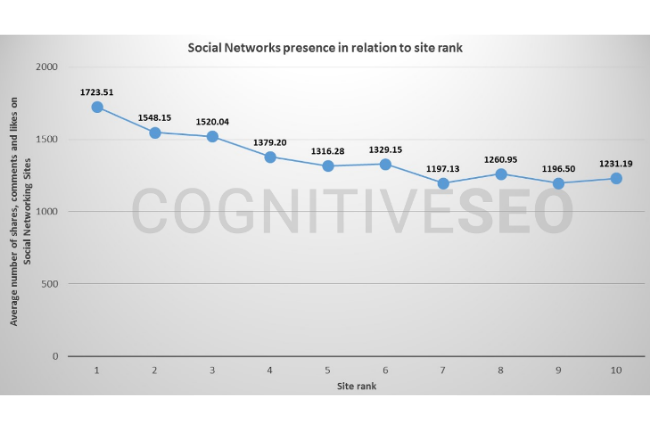That is why your site’s SEO ranking is crucial to the success of your business. With over 200 ranking factors for Google alone, navigating the ranking factors of SEO algorithms can be daunting. Luckily, there are ways to optimize your business’ social media marketing to help your content speak the language of the SEO algorithms, thus improving your overall search ranking and performance.
While Google has publicly said that social media isn’t a direct ranking factor there have been studies done, like this 2016 study from Cognitive SEO, that imply a positive correlation between Google rankings and social media signals.

Related: Complete SEO Glossary of SEO Terms for Beginners
While Google has denied any direct impact social media has on SEO ranking, as you can see there is at the very least an indirect impact between a strong social signal and a site’s SEO ranking. So, how can brands start to improve their social media SEO?
Here are 4 ways you can optimize your social media strategy to increase its relevance with SEO rankings.
1.) Emphasize Quality Over Quantity
SEO continues to evolve as the way we consume content evolves. Google algorithms and search engine bots are getting smarter and can now understand user intent, content relevance and quality. There can be pressure to produce content as frequently as possible to maintain relevancy with both your audience and the SEO ranking signals. But it is more important to produce quality content that resonates with your target audience of each social media platform to increase the likelihood of your content being distributed and linked to on social media networks. From Facebook to Twitter and everything in between, the more useful and relevant your content for social media platforms is to your audience, the more it will be shared amongst colleagues.
2.) Produce Targeted Content
While social media shares are not a direct SEO ranking factor, your brand’s backlink collection and average time on site are. The more people you can organically distribute your content to, the more time they will spend on your site, which can, in turn, help increase your SEO ranking and boost your brand awareness for potential customers. Google will see your content only as relevant and helpful as your audience does. Thus, connecting and engaging with your audience with social networking sites is your “Step Number 1” when trying to increase your SEO ranking in this chicken or the egg scenario. To do this, you must understand your ideal reader and what type of blog post they are actively looking for or already consuming. This is where social listening tools can come in handy, they allow you to see what your target audience is saying about your brand, industry, competitors or anything else that may be relevant to your business — which will help you identify high priority, relevant keywords to target and include in your blog content and social platform.

3.) Upgrade Your Social Media Profile
Before the digital age and SEO for social media, the receptionist of a business was one of the most impactful positions in the company as they were the face of your company and the first interaction any potential customer would have with your business. They needed to be helpful, engaging, knowledgeable and be able to make the customers experience as effortless as possible. Your social profiles are the digital face of your business. While the setting of first impressions have changed, the importance of a good first impression has never been more essential. With one Google search, customers have hundreds of options at their fingertips within seconds and you only have one chance to get their attention before the move on to the next search result. You can ask yourself these helpful questions when evaluating your own social channel:
- How engaging is my social media profile?
- What kind of information is my target audience looking for? Is that information displayed immediately on my profile?
- Are the keywords and messaging on my social profiles consistent across various platforms and blogs?
A routine social media audit will ensure your channels stay relevant. Maintaining a consistent set of determined and targeted keywords across social media sites is crucial to increasing your SEO rankings as keyword repetition helps your target audience find you.
4.) Modify Your Images for SEO for Social Media
While it is common knowledge that images help add context and increase engagement for any blog or social media post, what is less commonly known is that how you setup and insert images into your content can positively or negatively affect your SEO ranking. There are various ranking signals that SEO algorithms look at when evaluating images on webpages. We’ll take you through some of the most common mistakes marketers make when adding images to their content and some SEO best practices to follow.
Optimize Image File Names
While a quick one- or two-word file name might be enough for you to remember the image, SEO algorithms read and rank the file names a little more thoroughly. Be sure to name images with relevant, descriptive and hyphenated keywords (hyphens between keywords are particularly important as this is how SEO algorithms differentiate individual keywords) to increase SEO.
Use Alt Tags
You may be asking yourself, “What is an alt tag?” Essentially, it is a piece of HTML code applied to images that help search engines and bots interpret the image, giving them another positive data point that can help improve your SEO ranking.
Use Unique Images
In a pinch, using stock photography can seem like a quick and effortless way to add some flare to your blog or social media content without the work of taking your own custom photography. However, what you gain in convenience, you sacrifice in your sites SEO ranking. Popular stock photos are often used by many sites making it harder to set your site apart from an SEO It is always best practice to upload unique images whenever possible.
SEO marketing is a complicated ever-changing maze of data points, ranking signals and algorithms that can seem like a foreign language at times, even for social media marketing agencies. This is because it is. Hopefully, this blog helped you at least be able to ask “Dónde está el baño?” in social SEO.
Want to fine-tune your social SEO strategy? Talk to our paid media specialists fluent in SEO marketing and contact us today!



